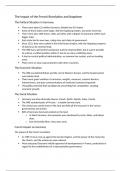The Impact of the French Revolution and Napoleon
The Political Situation in Germany
There were about 22 million Germans, divided into 314 states.
Some of these states were larger, like the Hapsburg empire, and some were tiny.
There were also 1400 towns, cities and cities with a degree of autonomy within each
bigger state.
Each state had its own laws, ruling class and styles of government.
Since 1512, they were united in the Holy Roman Empire, with the Hapsburg emperor
of Austria as its nominal head.
The HRE had a permanent parliament (call the Imperial Diet), but it wasn't possible
to achieve a unified position within it, due to so many conflicting views.
It had no central political administration, no common tax system, and no standing
army.
There were no clear natural borders with other countries.
The Economic Situation
The HRE was behind Britain and the rest of Western Europe, and the feudal system
was mainly intact.
There were great varieties of currencies, weights, measures, customs barriers,
internal taxes, and poor communications all restricted commercial growth.
The guilds protected their privileges by preventing free competition, stunting
economic growth.
The Social Situation
Germany was also ethnically diverse: French, Dutch, Danish, Poles, Czechs.
The HRE excluded parts of Prussia – a sizable German state.
The aristocracy owned most of the land and held all the key posts in the various
governments and armies.
80% of Germans lived and worked on the land.
o In West Germany, free peasants were burdened by rents, tithes, and labour
dues.
o East of the Elbe River, they were serfs.
French Impact on Germany
The impact of the French revolution
In 1789, France rose up against the Ancien Regime, and the power of the monarchy,
the church, and the aristocracy was reduced.
Many educated Germans initially approved of developments in France, particularly in
regard to the establishment of a representative government.
, They were less supportive when the French king was executed and by 1793, Austria,
Prussia and many other German rulers, anxious to stop the spread of revolutionary
ideas, were at war with France – a war they failed to win.
The Napoleonic Settlement
1803: France annexed the territory on the left bank of the Rhine.
1803-06: Small German states were absorbed into larger neighbouring ones – the total
number of states was reduced to 39.
1806: Bavaria, Wurttemberg, Baden, and 13 other south German states were
formed into the confederation of the Rhine – a third German power to offset
Austria and Prussia.
1806: The HRE was formally dissolved, and the Confederation of the Rhine was set
up.
1807: Prussia lost all its land west of the Elbe, much of which became part of the
kingdom of West Phalia. Prussia’s polish territories became the Grand Duchy
of Warsaw.
1809: Austria resumed war with Napoleon, expecting other German states to do
the same. They didn’t, and Austria was crushed by the French in the battle of
Wagram.
June 1809: The Peace of Schonbrunn, in which Austria conceded further territories and
was forced to pay crippling reparations. Napoleon married the emperor of
Austria’s daughter.
The Development of German Nationalism
French domination contributed to a sense of common cause and an emerging
German nationalism.
French Impositions
Most Germans were affected by the rising prices, heavy taxes, and French controls.
As the German economy was subordinate to French needs, it was severely disrupted
by napoleon’s continental blockade.
o Continental blockade – the boycott of British goods to force England to make
peace with them.
There was also military conscription.
o For example, when Napoleon invaded Russia in 1812, he did so with 600,000
troops, a third of whom were German. Only 100,000 troops returned.
As such, resentment started to build up against the French.
Spain and Portugal
In 1808, the Spanish and the Portuguese rose up against French rule.




